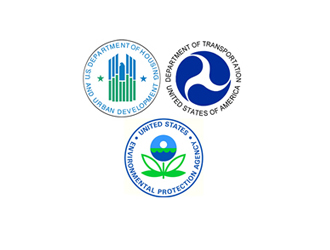Code for Livability
 The Partnership for Sustainable Communities is hosting a code-a-thon to brings together citizens, developers, and government personnel to work on solutions that bring sustainability to the forefront of peoples’ everyday lives. We want to provide citizens and governments with the information they need to make an informed choice, and we want to give them the opportunity to work together to make their communities more sustainable.
The Partnership for Sustainable Communities is hosting a code-a-thon to brings together citizens, developers, and government personnel to work on solutions that bring sustainability to the forefront of peoples’ everyday lives. We want to provide citizens and governments with the information they need to make an informed choice, and we want to give them the opportunity to work together to make their communities more sustainable.
Come Join Us in Creating Livable Communities!
January 22, 2011 at American Public Transportation Association, 1666 K Street NW, 11th Floor, Washington DC
Join the mailing list via Department of Transporation!
You should participate if you’re passionate about our livability principles, if you’re a community leader who needs tools to solve sustainability problems, or a developer who wants to help citizens and government work better together. Watch for more information coming to the Partnership for Sustainable Communities Web site soon!
Expected Outcomes: We hope to leverage federal data or create applications that generate new, open data sets that help citizens and governments advance their sustainability objectives. We have developed some initial problem statements to help get the conversation started. Join our Google Group to continue the discussion! Refine these problems, or introduce some problems of your own. As long as your problem statement aligns with our livability principles, it’s fair game for the code-a-thon.
- About 40,000,000 Americans move every year, according to the Census. About 60% of those Americans will stay within the same county, another 20% will stay within the same state, and the remainder will move to another state. We have an opportunity to provide these Americans with information that can help them make a more sustainable choice about where they want to live. You can help by developing applications that:
- Provide sustainability information alongside multiple listing services or apartment locator search Web sites. This information can be visual or textual.
- Provide the ability to narrow a search based on what sustainability performance metrics are important to that individual.
- Provide the ability to find “nearby communities” that are more sustainable than the one an individual is currently searching – taking into account that individual’s “what’s important” factors.
- Expressing the impact of making sustainable choices in terms that matter to an individual’s bottom line. How will moving to a more sustainable community impact my transportation costs? My electric bill? My water use?
- About 25% of the trips Americans take are less than one mile – and, yet, very little walking takes place. There are many potential reasons for this – physical barriers, unsafe conditions, or a lack of knowledge about conditions along a given route. We have an opportunity to help Americans get around their communities in a more sustainable way, and we have an opportunity to crowdsource walkability data:
- Enhance existing wayfinding applications to include information on factors that matter to making the choice to walk from point A to point B: connect walking with transit information, traffic volumes and speeds, and public safety information. This app could
- Create a walkability index to rate the desirability of a given route based on these factors
- Collect data about desired origins and destinations to be fed back to local planners, public works, transportation, and police departments to prioritize investments and allocation of scarce resources
- Crowdsource walkability information using existing tools, such as OpenStreetMap, Open311, or Ushahidi. Collecting data on gaps in sidewalk coverage, sidewalk conditions, unsafe intersections, or unsafe portions on routes will not only calibrate the tool contemplated above, but also reinforce the feedback loop above.
- Rate the walkability of a neighborhood based on the walkability to amenities that matter most to an individual: dry cleaners, parks, transit access, grocery stores, etc. Incorporate these amenities into a wayfinding app.
- Include information on hazards in the environment, including pedestrian fatality data from DOT or other pedestrian incident data from local police department data
- Enhance with information such as farmers market data (available from USDA) to evaluate access to sustainable amenities
- Enhance existing wayfinding applications to include information on factors that matter to making the choice to walk from point A to point B: connect walking with transit information, traffic volumes and speeds, and public safety information. This app could
Highlighted Data
- Housing Affordability Data System
- Components of Inventory Change (CINCH) reports
- American Housing Survey
- EPA Datasets
- EPA Data Services
- EPA Data Finder
- EPA Ideas for Apps
- Apps for the Environment
- State Energy Data System
- Annual 1990 - 2009 Average Electricity Price by State by Provider
- Annual 1990 - 2009 U. S. Electric Power Industry Estimated Emissions by State
- Retail Gasoline Prices All Grades, Areas and Formulations
- National Household Travel Survey
- Census Transportation Planning Products
What's Already Been Done?
Examples of existing innovations include WalkScore, the Center for Neighborhood Technology’s Housing and Transportation Index, a Code for America called Reroute.it, and many others.
Get Recognized, Feel Rewarded
We’ll have swag, and we are working on additional prizes and recognition awards. Stay tuned to the Partnership for Sustainable Communities Web site for more information.


